Best Fountain Pen For Drawing
Many urban sketchers choose to sketch with a fountain pen, rather than a fineliner, such as a Micron or UniPin. I always wondered why this was when I started out. I thought it was a bit eccentric, to be honest. Surely it couldn't be easy to draw with a fountain pen?
Why Sketch With a Fountain Pen?
There are a number of reasons people sketch with fountain pens, here are a few:
- They're more comfortable to draw with due to the way the ink flows from the pen
- You can achieve more expressive lines by being able to vary line weight (the thickness of the line)
- Environmentally friendly as they are refillable rather than disposable
- It looks cool!
That last point was me being a little bit flippant, however, full disclosure: I wanted to be one of those people who sketch with a fountain pen because it does look so much cooler! Especially if you have a fancy looking fountain pen. There we go, my superficiality is laid bare for you all to judge me!
So, as I mentioned above, sketchers use a variety of different pens, but generally, I find sketchers either use a fineliner or a fountain pen. Occasionally, I see sketchers use dip pens but not so much out on location as it's a bit awkward.
What is a Fineliner?
Fineliners are also known as technical pens. They are available in a range of thicknesses, such as 005 (which is super fine), 0.1, 0.2, 0.3 and so on. Usually, in sets of fineliners, the thickest pen will be 0.8, such as in this set of Microns I bought from Amazon. Microns are a popular brand but you can various other brands of fineliners in most art shops. Popular choices are Uni Pin, Staedtler, Copic and Faber-Castell. As long as the ink is waterproof then use whatever you can find!
I have tried all of the previously mentioned brands and liked them all except Faber-Castell. For some reason, I just do not find them nice to draw with. I was out sketching one day and it started to rain and my ink smudged everywhere, even though they are supposed to be waterproof. I have not had that experience with other brands.

I mainly use Pigma Microns or the Uni Pins. I have only recently tried and Copic and I really do like drawing with those too. They are slightly more expensive than the other brands I have mentioned, however, you can replace the nibs of the pens and also refill them. So, this could explain the slightly higher price tag.
Fineliners generally come with black ink but you can also buy them with sepia ink or grey ink too. I believe Uni Pins come in blue and red as well. I generally stick with black but I do have Faber-Castell pens with sepia ink.
Why do Urban Sketchers Use Fountain Pens?
Let's dive into the reasons why urban sketchers use fountain pens a little bit further. I have researched comments and interviews from urban sketchers around the world as to why they prefer to use a fountain pen to sketch and this is a round-up of what they said:
- Feel more comfortable to use
- Smoother to draw with due to the way the ink flows from the pen to paper
- Ability to sketch at more of a slant than with a fineliner, therefore it's more comfortable to draw in a sketchbook
- Can make more expressive lines, especially if you have a pen with a flexible nib
- Great for sketching loosely
- Environmentally friendly opposed to disposable fineliners
- A long-lasting tool you can form an attachment to
- Economical over the long run – if you use a converter you can keep refilling the pen from a bottle of ink
- Choosing your own ink to fill the pen with, you can decide on the quality and colour
- The pen gets better over time and becomes nicer to use
- Fountain pen sketchers are in a scene! There's quite an enthusiastic community surrounding the use of fountain pens not only for writing but more specifically for drawing.
Which Fountain Pen is Best to Sketch With?
There are a few factors to take into account when selecting a fountain pen.
Nib size
Choosing a nib size can be quite difficult, especially if you have no frame of reference to make your decision. I bought my Lamy Safari with a medium nib because quite honestly at that point I had no idea there were other options. Over time I began to realise sketchers used other nib sizes. After a little investigation, I found I could simply just buy a different nib for my Lamy pen (and not a whole new pen) as changing nibs on the Lamy Safari is very easy. This is not the case with all fountain pens so best to research your specific pen.
It took a while but I found a nib at Cult Pens, a company in the UK (where I was living at the time). I bought an extra-fine (EF) nib based on the fact I thought my medium nib produced far too thick a line, and this is why I did not use it as much as I would have liked to sketch with. I was pleased with the EF nib, although the line was still thicker than I had expected! I wondered why this was.
As it turns out, nib size completely varies across manufacturers. An extra-fine nib for a Lamy Safari will most likely be a different line width to an extra-fine nib for a Pilot pen for example.
A lot of pen makers will manufacture their own nibs in-house and there is no international standard for what line width an extra-fine, fine, medium or broad nib should produce.
There are two countries who mainly manufacture nibs, Japan and Germany. You will find the Japanese extra fine and fine nibs actually have a finer line than their German counterparts.
There are other factors which affect the performance of a nib, such as the ink used, the paper and even the writer/sketcher themselves (like the angle you write at, the pressure you place on the pen and the speed you write at).
An incredible place to start when considering nib size choice is the Goulet Pens website. They have an area called 'Nib Nook' where Brian (the owner of Goulet Pens) has personally written with every single nib for every pen, using the same ink and on the same type of paper. This as good a resource as you can imagine without doing the same test yourself, which would, of course, be fairly impossible.
Nib flex & material
As well as size, the amount of 'flex' a nib has is also a factor to consider. The more flexible the nib is the more you can vary your line width by applying varying amounts of pressure.
Gold nibs will always be more flexible than stainless steel nibs given the nature of the metal, however as I am sure you can guess, gold nibs are more expensive.
Fude Nibs
Fude nibs are nibs that look bent or curved at the end. You can vary your line width by the angle you use the pen. Traditionally used for writing calligraphy, fude pens are great for sketching loosely with.
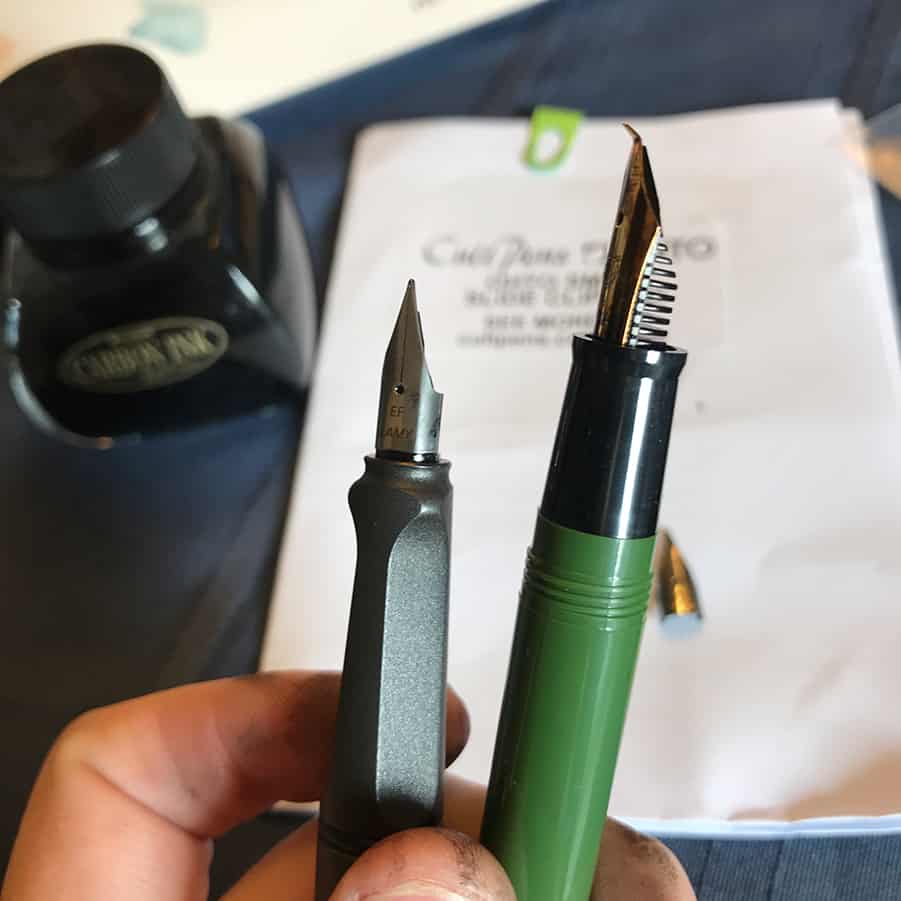
I have a Sailor Fude De Mannen, the green one with the nib bent at a 55-degree angle (the black version has a 40-degree angle nib). I bought it from Amazon but have since found them available at Cult Pens (UK) for those of you based in the UK.
It's a nice cheap pen to start with but from what I've read it's not the best option. I suppose this is not all that surprising considering the price. It's a stepping stone – if you like the idea of the pen or the style of sketching with it you could always upgrade.
From my research, I think a good step up would be the Duke 551 Confucius Fude Nib Fountain Pen. It's not even that much more expensive than the Sailor. It's on my list and I hope to be trying it soon – I shall update this post with my thoughts about it when I do.
Design of the Pen
This is where trying out a pen in real life would certainly help. It is tricky to know whether you will find a fountain pen comfortable to use based on photographs.
Some sketchers like the long narrow bodies of pens like the Lamy Joy, Platinum Carbon and Rotring Art Pens as they are nicely balanced. It may start to drive you crazy if you cannot place the cap on the end. I tend to lose pen caps if they're not wedged on the end of the pen!
The Lamy Safari 'triangular' grip is very comfy for a lot of people. Fineliners can be uncomfortable to use for longer periods of time because they are completely round and don't have any sort of ergonomic grip. Some fountain pens are the thickness of a fineliner and others have larger barrels. If you have big hands a more substantial pen is probably going to feel more comfortable than a light thin pen.
Depending on your hand strength you may prefer the feel of a lighter or heavier pen depending what's most comfortable for you. A heavier pen may be uncomfortable for longer sketching sessions if you find your hand generally fatigues quickly from sketching anyway.
Price
The price of fountain pens can vary phenomenally. In the video below you see Peter Draws and fellow Youtube and pen enthusiast, David from Figboot on Pens, experiment with pens up to US$2000 in price.
If you want to nerd out for an hour or so, be my guest and watch the video below!
For the rest of us, let's continue.
You can pick up a fountain pen for very little money, and to be honest, this is a good place to start. Unlike some other tools, I think starting at a relatively cheap price point is not going to hold you back much. Fountain pens have a hardcore cult following. People can geek out about them and as such there are many blogs, forums and threads devoted to discussing the finer points of materials, craftsmanship, ink flows and optimal paper surfaces. To be honest, this does not float my boat so much. I just want a pent that works and feels nice to draw with (oh, and that looks cool of course).
I would consider taking a more expensive step up if I tried a pen that blew me away. I know now that I love sketching with fountain pens and would use one exclusively. It's tricky buying on the internet. Most of us do not have access to a store where we can go and experiment with a vast array of pens until we find the one we like, or it finds us. I'm envisaging Harry Potter and wand-shopping right now. If only the perfect fountain pen could find us in such a way!
How Do You Sketch With a Fountain Pen?
There's no big secret that you're not aware of to sketch with a fountain pen. The main thing is getting to used to your particular pen, the angle you hold it at, how you can manipulate your line weights with it etc. The key is to use it regularly and get to know it. With that in mind here are a few considerations to bear in mind:
- Paper is important, you want your pen to glide across the surface. You do not want your ink to bleed through the page or your lines to feather.
- You can rotate your pen so the nib is facing in the opposite direction than you would usually use it, this will produce a finer line.
- Hold your pen towards the end of the handle to get a looser sketching style
- Don't put too much pressure on the nib, let it glide across the paper. If you are feeling it getting scratchy, or the ink isn't flowing smoothly, it may need cleaning out.
Things to be aware of:
- If using ink such as Platinum Carbon Ink (i.e. permanent waterproof ink), you should wash your pen out every few days, especially if you are using a fine or extra-fine nib as the nib will clog with ink more quickly.
- After lots of drawing the nib will clog with paper fibres which will affect your linework. This is not something to worry about, just to be aware of.
- Store your pen upright in a pen holder or cup, if you leave it lying down the ink will dry up in the nib.
What's a Converter?
A converter is a refillable reservoir that you can fill from a bottle of fountain pen ink.
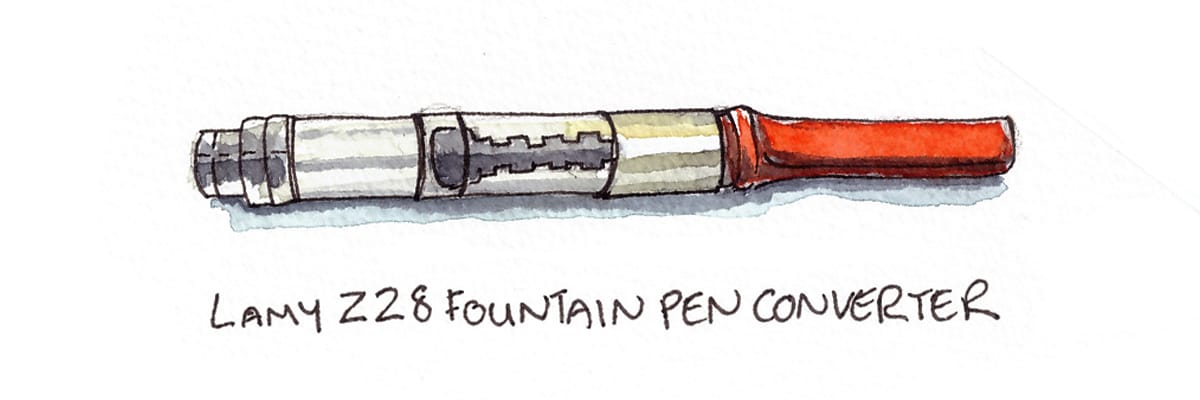
A converter fits into a fountain pen just like a normal ink cartridge does. As it allows you to refill your pen directly from an ink bottle, it opens up a whole array of ink types and colours to sketch with.
There are different types of converters but the main types are piston and squeeze converters.
A piston converter is the most common, and this is the type I use in my Lamy Safari and my Sailor Fude pen. Twisting the knob at the end of the converter moves a piston inside the barrel. Depending on which way you twist the know the piston will move up or down, creating a vacuum inside the barrel in order to draw ink into it.
A squeeze converter works by squeezing the air out of the barrel and then releasing it to draw ink up into it. I have actually not seen a pent that uses one of these converters, I think its an older style.
Not all pens are compatible with all converters, you need to be sure you buy the right converter for your pen. Converters are designed to be a tight fit, so don't be scared to exert a bit of force to get the converter in.
Which Fountain Pen Ink to Use?
There is a huge range of bottled fountain pen ink to choose from. Cult Pens alone have 400 different colours and you can even mix your own colour. Despite what might be said by pen manufacturers, you can use any brand of ink in any fountain pen.
Do not use calligraphy ink in your fountain pen!! It is far too thick to be able to flow properly and you will just end up clogging your pen, possibly ruining it!
The most important thing for us as urban sketchers to note is that most fountain pen ink is not waterproof. This obviously presents an issue if we want to sketch and then paint with watercolour over the top.
The reason fountain pen ink is generally not waterproof is that it needs to be a thinner, finer consistency to flow through the pen. Thicker waterproof ink will be more likely to clog the pen.
Dye-based inks are the most common type of fountain pen ink but the least water-resistant. However, there is a sub-category of dye-based inks called bulletproof ink which is made to be water-resistant. Noodlers have bulletproof ink which I see many artists use in their fountain pens.
Then there are pigment-based inks which are waterproof. I use Platinum Carbon Ink and I'm very happy with it. It is definitely waterproof. I do find my Lamy Safari gets clogged up fairly often but this is a combination of using a fine nib and not using the pen as often as I should in order to keep the ink from drying up in the nib.
Another popular waterproof ink many sketchers use is De Atramentis Document Ink which comes in a wide variety of different colours.
A clogged pen is a common issue with using pigment-based inks but something you just need to keep on top of if you want to sketch with a fountain pen and use watercolour paint over the top. The general guidance is clean your pen every month OR if you do not use it for a week or so. It is frustrating to come back to your fountain pen and find the ink has entirely dried up and it's unusable until you clean it all out. The key is to use the pen regularly I guess!
How Do You Refill a Fountain Pen?
This may seem a basic question BUT I was doing it wrong for a while. Yes, I do feel a little stupid but I guess we all need to start somewhere!
So I have my Lamy Safari, and I bought the converter to go inside of it so that I could refill my pen with permanent waterproof ink of my choosing (black Platinum Carbon Ink in my case).
I found each time I ran out of ink (which was not very frequently as I was not using it all the time) I would take the converter out of the pen, make sure it was screwed all the way to the bottom and the reservoir was empty. I then put the end of it in the ink bottle and screw the piston upwards so the ink gets drawn into the tube of the converter. I then put the converter back in the pen and scratch away until ink came through. This is not the correct method.
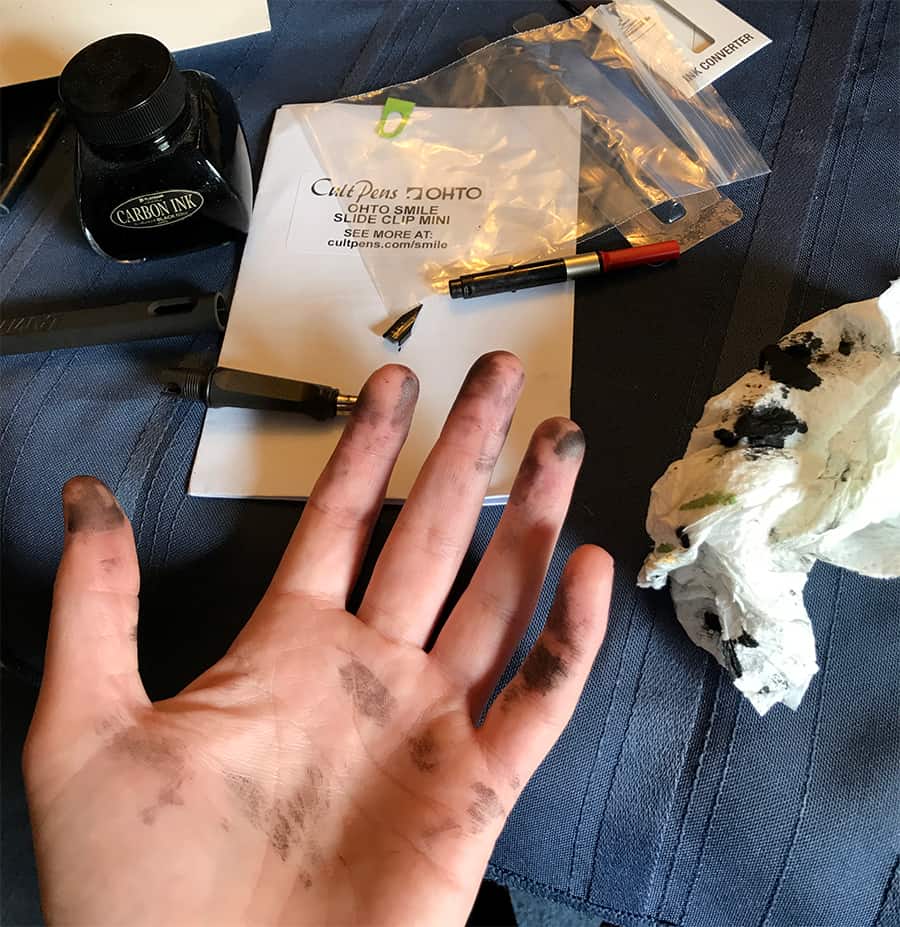
How to Use a Fountain Pen Converter Properly?
What you should do is leave the converter in the pen. Ah. Unscrew the barrel of your fountain pen so you can access the converter. Make sure the converter is screwed all the way down (hold your pen over the ink bottle or paper towel if you think some ink may come out when you do this). Then put the nib of your fountain pen into the ink bottle and screw the converter upwards sucking the ink through the nib and into the converter until filled.
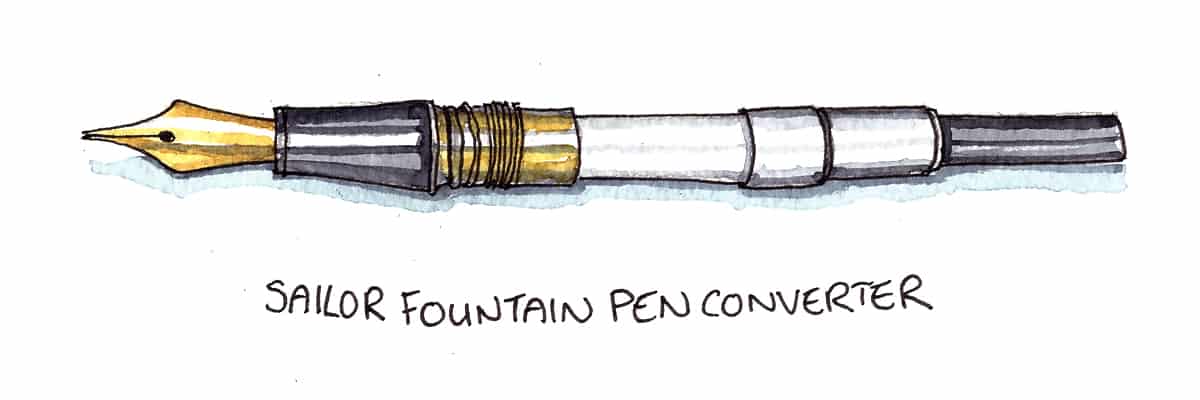
Check out my video here, I'm unboxing my two new fountain pens, a Lamy Al-Star and a TWSBI Eco. I also show you how I refill each of them. The Lamy needs a converter (a Lamy Z28 pictured in the 'What's a Converter' section above) but the TWSBI Eco doesn't as the pen is its own converter, the whole body of the pen is an ink reservoir. You cannot put an ink cartridge in it. Check out my video below to see it in action:
This is so much easier than what I was doing! By submerging the pen in the ink it primes the nib as the ink has already travelled through it. You don't have to scratch away waiting for the ink to come through and wondering if your pen is blocked up and requires cleaning…which seamlessly leads me to the next topic of discussion…
How Do You Clean a Fountain Pen?
It is quite likely your pen will get blocked up and stop working. If you only use your fountain pen a handful of times in the space of the month, then this is more likely. If like me, you have an extra-fine nib on your pen then this will also cause the pen to block up more regularly. As the nib is so much finer, it is more likely to get blocked by the heavy permanent ink you have flowing through it (or not as the case may be).
Take the pen apart and remove the cartridge or converter. Be careful if there's still ink inside – place the cartridge or converter on a paper towel or in a cup (so the opening is facing upwards and the ink cannot accidentally spill out).
Run water through the nib section of the pen (where you would usually insert the cartridge/converter) until the water runs clear. Only use cold water, hot water could damage the pen. Let the section dry for several hours, or overnight. I usually balance mine against a hard surface so the section is as vertical as possible with the nib point facing down on top of a paper towel so that the moisture can be absorbed as much as possible.
You can also clean out the converter. Hold the converter over a paper towel and screw the knob so the piston has pushed all the air and excess ink out of the reservoir. Then flush the converter with cold water to dislodge any ink particles. Run water through very lightly as you do not want the water to get behind the piston seal as it may cause a mouldy blob of ink to be trapped behind it which is then very difficult to remove. Rince the converter gently until the water runs clear and it looks clean and then place it upright on a paper towel and leave to dry overnight.
Recommendations
There is a reason you see Lamy Safari fountain pens in nearly every single urban sketchers kit. They are widely available across the world, are fantastic fountain pens and very reasonably priced. It's an excellent pen to start off with to see whether you enjoy sketching with a fountain pen. You can buy a converter for it too and keep refilling from a bottle of ink if you so wish. Be aware, the ink cartridges the Lamy Safari comes with are not waterproof!
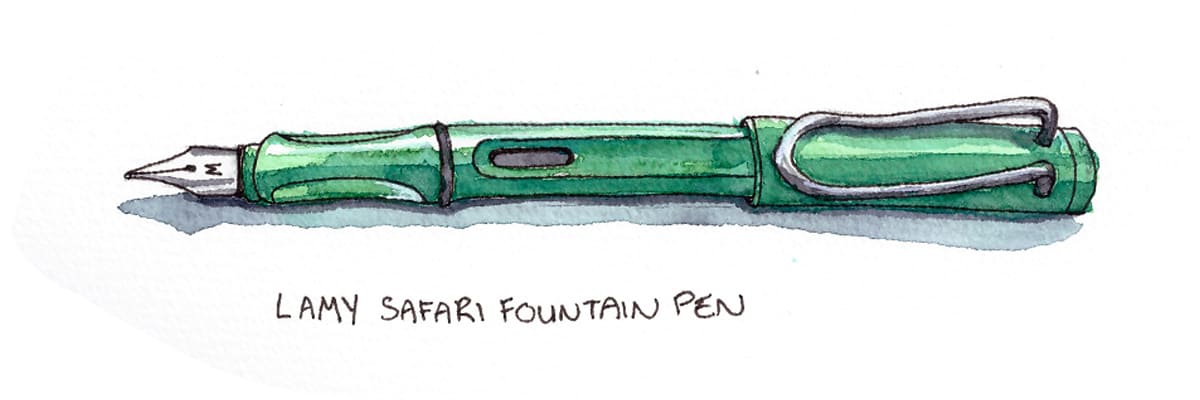
Other great options to start off with are the Rotring ArtPen or the Platinum Carbon fountain pen as both are relatively inexpensive but nice to draw with.
The Platinum Carbon pen accepts Platinum Carbon ink cartridges which contain waterproof ink, so if you do not like the idea of using a converter or refilling your pen then this is an excellent choice. It's pretty cheap too – approximately US$12.
Having recently bought a Lamy Al-Star, I can also recommend this pen. It's a bit more expensive than the Lamy Safari though and perfomance-wise it doesn't really seem any different. Perhaps I just paid more for a fancy colour?
The TWSBI Eco is also a great option. It is a much chunkier pen than the Lamy so may not be comfortable for all hands. I like sketching with it, the nib seems very precise. I chose the extra-fine nib which I'm very happy with, it produces a lovely line that's not scratchy or too fine. As mentioned above the pen does not accept cartridges, you need to refill it from an ink bottle as the 'converter' is built into the pen body. As such it holds an enormous amount of ink, which is great of you are sketching all day everyday with it. If not, I would say do not fill it up to the top, just half fill it. You do not want it to get clogged up (see the section above about cleaning your fountain pen).
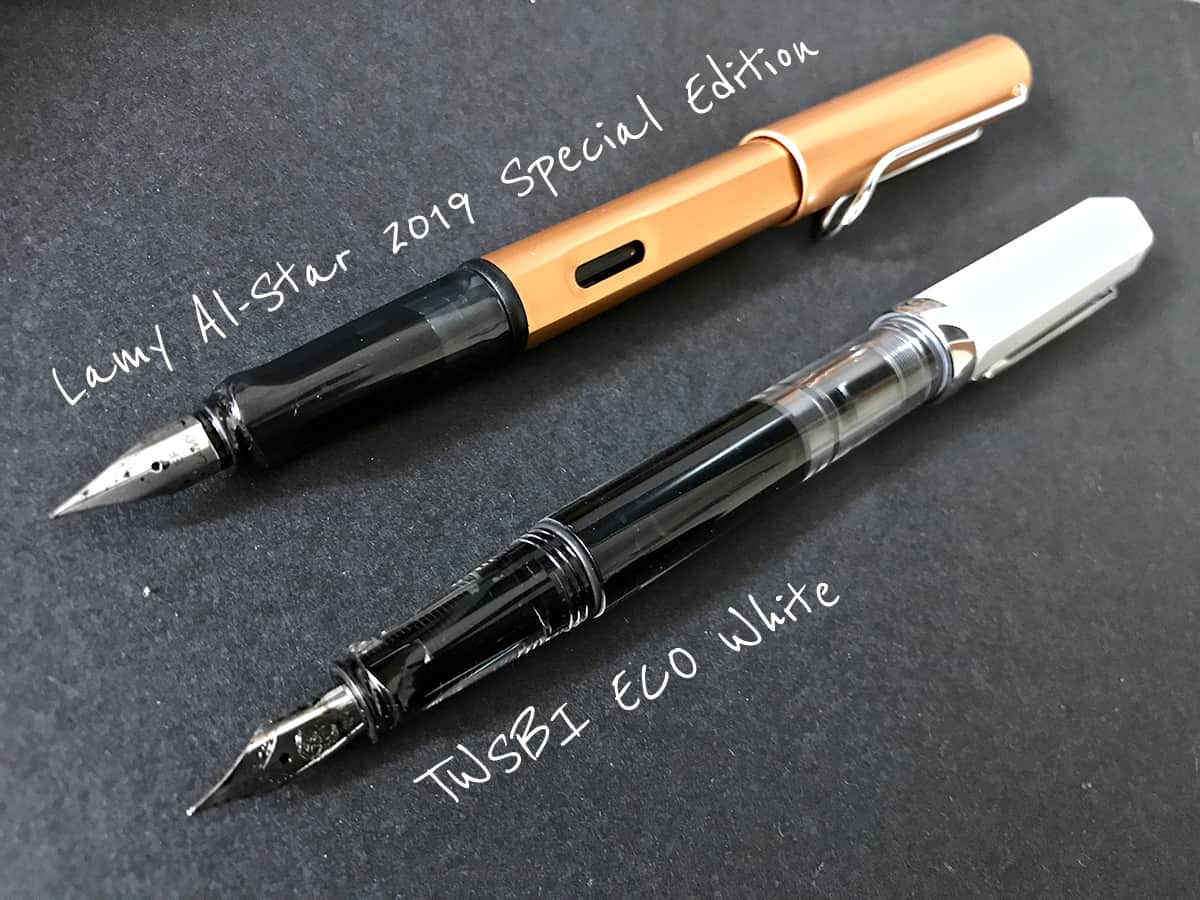
Once you are used to drawing with a fountain pen and if you wish to upgrade I would suggest checking out the Pelikan M100 but this is purely based on how much Teoh Yi Chie loves this pen. It seems to be his go-to option. I have not used one as it is quite a jump upwards in price.
As mentioned, I have seen that gold nibs are more flexible and therefore better to sketch with.
To be honest, I am perfectly happy with my combination of the Lamy Safari and the Sailor Fude for more expressive calligraphic mark-making, although I am keen to upgrade my fude nib pen to the Duke 551 pen I mentioned earlier – its a gorgeous looking pen too.
I think if you start out with a Lamy Safari you can't go far wrong and I for one have no real urge to move away from that particular pen any time soon – I may in fact just get more of them and fill them with different coloured inks instead!
Best Fountain Pen For Drawing
Source: https://urbansketchingworld.com/sketching-with-a-fountain-pen-why-how-and-which-one/
Posted by: murphyconst1993.blogspot.com

0 Response to "Best Fountain Pen For Drawing"
Post a Comment